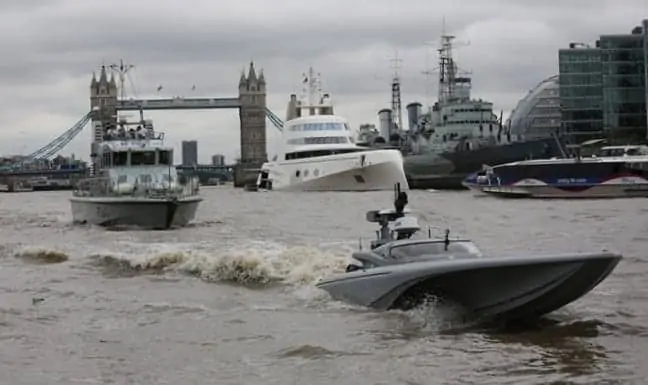The UK’s Maritime Autonomy Surface Testbed (MAST), an unmanned surface vessel (USV) based on the innovative Bladerunner hull shape, has undergone trials in the Tidal Thames.
MAST is being developed by Portchester-based ASV Ltd, under research funding from the Defence Science and Technology Laboratory (Dstl), providing a testbed to host a range of new technologies which allows the Ministry of Defence to test and evolve tactics for employing maritime autonomous systems.
The 32ft MAST is one of over 40 Autonomous Systems taking part in Unmanned Warrior 2016 this autumn, off West Wales and NW Scotland and the Western Isles.
In conjunction with industry and international partners, the Royal Navy has created an exciting opportunity for engineers and scientists to demonstrate state of the art technology during Unmanned Warrior, the biggest event of its kind, and explore the ideas that will help shape the future of Naval Warfare for decades to come.
It is linked with the regular Joint Warrior fleet Exercise and aims to test systems in an operational environment.
Admiral Sir Philip Jones, First Sea Lord and Chief of Naval Staff, said: “The growing scale of Unmanned Warrior is a clear demonstration of the Royal Navy’s ambition to lead and win through technological innovation.
“Unmanned maritime systems will change how we operate, but they’re just the start. Our pursuit of new technologies and ideas – from big data to 3D-printing – will ensure we remain one of the most capable and successful navies in the world.”
MAST is a unique UK designed and built craft capable of reaching high speeds on which high speed autonomy can be investigated. Various levels of autonomy include basic remote control up to autonomous navigation.
The craft is designed to operate autonomously in an unmanned mode, sensing other vessels in the immediate vicinity and avoiding them in a safe manner. The avoidance algorithms are designed to comply with internationally mandated collision regulations. When operating on a busy waterway (such as the Thames), the craft is operated with a coxswain on board ready to take control.
It does not carry weapons, but is designed to explore autonomous capabilities and support non-lethal surveillance and reconnaissance roles.
The work is funded through Dstl (Defence Science and Technology Laboratory), who conduct research on behalf of the Royal Navy (and the other UK armed forces). The work is being conducted by civilian manufacturers ASV Ltd & Roke Manor Research, with support from Cambridge Pixels, Seebyte and Chess Dynamics.
Fleet Robotics Officer Commander Peter Pipkin said: “This is a chance to take a great leap forward in Maritime Systems – not to take people out of the loop but to enhance everything they do, to extend our reach, our look, our timescales, our efficiency using intelligent and manageable robotics at sea.”
Vince Dobbin, Sales and Marketing Director, ASV Global said: “ASV Global has been working in the maritime autonomy industry for many years. We have a long-standing partnership with Dstl, part of which includes working on the Bladerunner vessel.
“Our role in this programme has involved developing the autonomous capabilities of this fast vessel. This capability will be demonstrated at Unmanned Warrior in October showcasing the UK’s position at the forefront of delivering this revolutionary technology.”



















